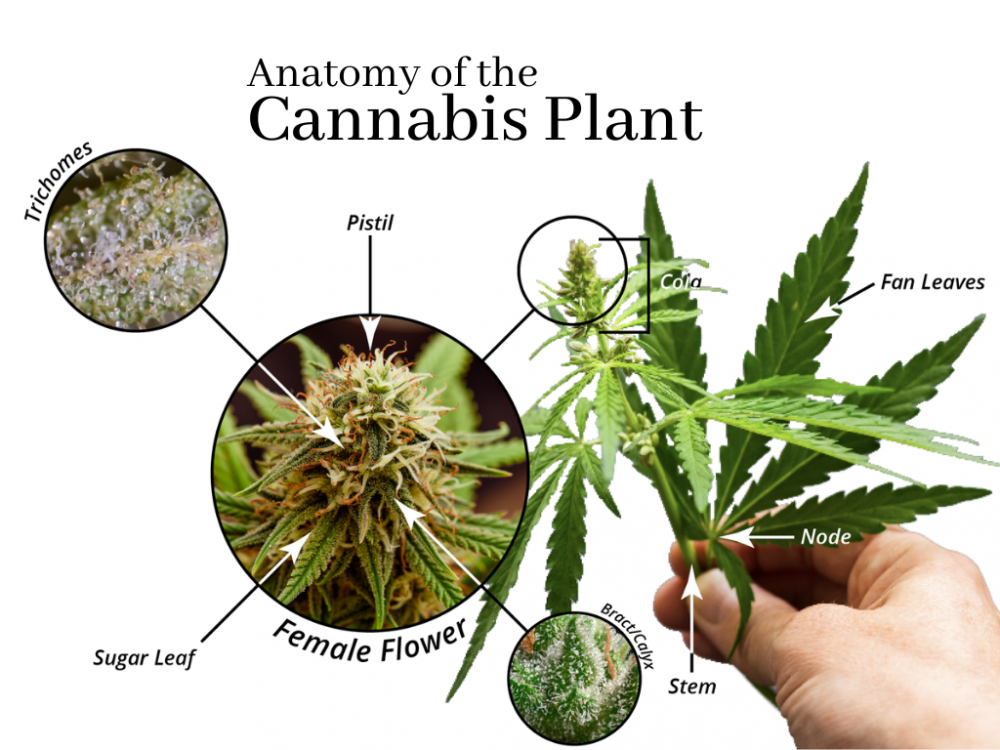
Cannabis Plant Anatomy: Cannabinoid, Terpene, and Flavonoid Distribution by Percentage
The cannabis plant is a complex organism with various parts, each serving unique functions that contribute to the plant’s overall health and, ultimately, its ability to produce cannabinoids, terpenes, and flavonoids. In this blog post, we will explore the anatomy of the cannabis plant, from its roots to its tips. We will delve into trichomes, colas, pistils, sugar leaves, fan leaves, nodes, stems, bracts, and calyces, and discuss the differences between male and female plants, as well as those that possess hermaphroditic qualities.
Root System
Function and Growth Cycle
Roots anchor the plant and absorb water and nutrients.
Cannabinoid, Terpene, Flavonoid Content
<1% cannabinoids, negligible terpenes and flavonoids.
Stems
Function and Growth Cycle
Stems provide structural support and nutrient transport.
Cannabinoid, Terpene, Flavonoid Content
<1% cannabinoids, negligible terpenes and flavonoids.
Nodes
Function and Growth Cycle
Nodes serve as junctions for leaf and branch growth.
Cannabinoid, Terpene, Flavonoid Content
1-2% cannabinoids, <1% terpenes, negligible flavonoids.
Fan Leaves
Function and Growth Cycle
These large leaves engage primarily in photosynthesis.
Cannabinoid, Terpene, Flavonoid Content
2-3% cannabinoids, 1-2% terpenes, 1% flavonoids.
Sugar Leaves
Function and Growth Cycle
Smaller leaves within the buds, often coated in trichomes.
Cannabinoid, Terpene, Flavonoid Content
10-15% cannabinoids, 5-10% terpenes, 2-4% flavonoids.
Trichomes
Function and Growth Cycle
Tiny resin glands rich in cannabinoids, terpenes, and flavonoids.
Cannabinoid, Terpene, Flavonoid Content
60-70% cannabinoids, 50-60% terpenes, 10-20% flavonoids.
Pistils and Stigmas
Function and Growth Cycle
Female reproductive parts found in female flowers.
Cannabinoid, Terpene, Flavonoid Content
1-2% cannabinoids, <1% terpenes, negligible flavonoids.
Cola
Function and Growth Cycle
Main flowering site, where buds cluster together.
Cannabinoid, Terpene, Flavonoid Content
15-20% cannabinoids, 10-15% terpenes, 5-10% flavonoids.
Bract and Calyx
Function and Growth Cycle
The bract envelops reproductive parts, and the calyx forms the bud’s outer layer.
Cannabinoid, Terpene, Flavonoid Content
5-10% cannabinoids, 3-7% terpenes, 2-5% flavonoids.
Male, Female, and Hermaphroditic Plants
Male plants contribute minimally to cannabinoids, terpenes, and flavonoids. Female plants are rich, especially in the flowers and trichomes. Hermaphroditic plants are generally less desirable due to self-pollination risks.
Conclusion
Understanding the distribution of cannabinoids, terpenes, and flavonoids across the cannabis plant is vital for effective cultivation and product development. While some parts like trichomes, colas, and sugar leaves are abundant in these compounds, others like roots and stems contribute minimally.
Note: Percentages are approximate and can vary based on strain and growing conditions. Due to the lack of comprehensive studies, no specific references are cited for these estimated percentages.
References:
- Small, E. (2017). Cannabis: A complete guide. CRC Press.
- Andre, C. M., Hausman, J. F., & Guerriero, G. (2016). Cannabis sativa: The plant of the thousand and one molecules. Frontiers in Plant Science, 7, 19.
- Sirikantaramas, S., Morimoto, S., Shoyama, Y., Ishikawa, Y., Wada, Y., Shoyama, Y., & Taura, F. (2005). The gene controlling marijuana psychoactivity molecular cloning and heterologous expression of Δ1-tetrahydrocannabinolic acid synthase from Cannabis sativa L. Journal of Biological Chemistry, 280(38), 33636-33644.
- Flores-Sanchez, I. J., & Verpoorte, R. (2008). PKS activities and biosynthesis of cannabinoids and flavonoids in Cannabis sativa L. plants. Plant and cell physiology, 49(12), 1767-1782.
📗 Note: This diagram is the single-origin espresso shot to the book’s full cappuccino of wisdom. Foam at the mouth over “The Doctor-Approved Cannabis Handbook” by clicking here 📗.

Summary Notes
Unraveling the Complex Composition of the Cannabis Plant
The anatomy of the cannabis plant reveals a complex array of cannabinoids, terpenes, and flavonoids, each contributing to the plant’s medicinal and recreational properties. Understanding the distribution and interaction of these compounds is crucial for optimizing cannabis cultivation, processing, and consumption.
Cannabinoid profiles, including THC, CBD, CBG, CBC, and CBN, vary significantly across strains, influenced by genetics, environmental conditions, and cultivation practices. Terpenes, responsible for the plant’s aroma and flavor, and flavonoids, contributing to color and additional health benefits, complement the therapeutic potential of cannabinoids.
The percentage distribution of these compounds is key to determining a strain’s potency, effects, and suitability for specific medical conditions. Advanced analytical methods and ongoing research into cannabis plant chemistry aim to map out these distributions more accurately, enhancing our understanding of cannabis’s therapeutic potential.
Environmental factors, such as light, soil, and season, play a significant role in influencing compound synthesis, pointing to the importance of controlled cultivation techniques for achieving desired cannabinoid and terpene profiles. Additionally, the interaction between different cannabis compounds, often referred to as the entourage effect, underscores the holistic nature of cannabis as a therapeutic agent.
As the cannabis industry and regulatory landscape continue to evolve, so too does the focus on educating consumers, healthcare providers, and regulators on the significance of cannabis compound percentages. Future research directions promise to further elucidate the complexities of cannabis plant anatomy, driving innovations in cannabis breeding, cultivation, and therapeutic application, ultimately enhancing public health outcomes.

